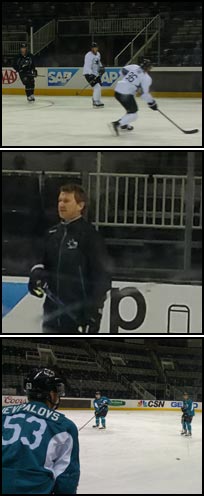(Originally published at Sports Radio Service)
In their first appearance in the Stanley Cup Final, the San Jose Sharks are in a good position to win, and so are the Pittsburgh Penguins. Not surprisingly, the two teams accumulated were very similar numbers on their way to the Final. Perhaps those are just the kind of numbers winners needed this year. Perhaps they are as irrelevant as statistics from the regular season. The Sharks and the Penguins could play each other four times or seven times, and it won’t add up to the number of games they played getting here. Games, and by association the series, can still be won or lost on a bounce. Either team could have trouble adjusting to a new sort of opponent, a heretofore unseen weakness could be exposed. This is why they play the games, because the NHL can’t award the championship based on past performance. Still, the likeness is uncanny.
Statistically, the Sharks and the Penguins are pretty even when you balance offensive and defensive numbers. The Sharks’ power play has a slightly higher success rate at 27%, with he Penguins scoring just 23.4% of the time. But balanced against the penalty kill, where the Penguins have been slightly better than the Sharks (83.4%-80.4%), the power play difference is even more negligible than 3.6%.
In shots per game, the Penguins have 35.1 where the Sharks have 28. San Jose’s Joe Pavelski and Brent Burns have taken 60 and 61 shots respectively, but Pittsburgh’s Phil Kessel has thrown a whopping 73 shots at the net. Again, put next to the shots against per game, it evens out. The Sharks have allowed an average of 27.1 while the Penguins averaged 29.7.
In goals, the numbers are so close (Sharks at 3.5 and Penguins at 3.22) that a counterbalance is hardly necessary, which is a good thing for Pittsburgh since the Sharks have allowed an average of 2.28 while the Penguins allowed 2.39. That gives a tiny edge to the Sharks in the area of goal differential.
The counterbalance actually comes from the fact that the Penguins have shown greater depth in scoring. The Sharks have more goals but they have come from fewer players. The Sharks have seven skaters with five or more goals in these playoffs, and four more with two to four goals. That gives them eleven skaters with more than one goal. The Penguins have just five skaters with five or more goals but eight with two to four goals, for a total of thirteen skaters with more than one goal. It is not a big difference, but neither is the difference between how many goals the teams have scored on their way to the Final.
The Penguins may have an edge in experience because they do have some players who have competed for and won a Stanley Cup in the past. Only the Sharks’ goaltender Martin Jones can say that, though he did so as the backup goaltender. The Sharks have plenty of players with enough mileage that, if they do not know what it takes to win at this level, they will probably learn quickly. I would not put a lot of stock in the “been there” factor.
In goal, the teams have fairly similar situations. Both teams, coaches and players, have talked about how calm and unflappable their young goaltender are. Martin Jones has more NHL starter experience but he is still in his first season. He has not been replaced during the playoffs, he has started every game for the Sharks. Jones put together a .919 save percentage through the first three rounds, with the full demonstrable confidence of his coach and his team.
The fact that the Penguins’ Matt Murray came onto the scene later than Jones should not be held against him. Marc-Andre Fleury was the presumptive playoff starter for most of the season. That Murray had to earn his spot very recently could be an asset if he is still trying to establish himself. The Penguins did experiment, having Fleury start a game in Murray’s place, and Zatkoff started a game before Murray did. Even if any of that undermined Murray’s confidence, he still played well enough to help his team win. His save percentage has been .875. Jones seems to have the edge over Murray there, but those numbers can change quickly.
Ultimately, few of these comparisons matter. All of the games played to this point were conference exclusive. The Sharks’ numbers were against western teams, the Penguins’ against eastern. The Sharks had to defeat a recent Cup winner, and then defeat the team that defeated another recent winner. It would not be outrageous to say that it is harder to score a goal, or prevent one, in the west. But it would be pure speculation since the Final is the only time East meets West. Both teams earned their spot in this series, and the odds are good that they will both bring their best games yet.



